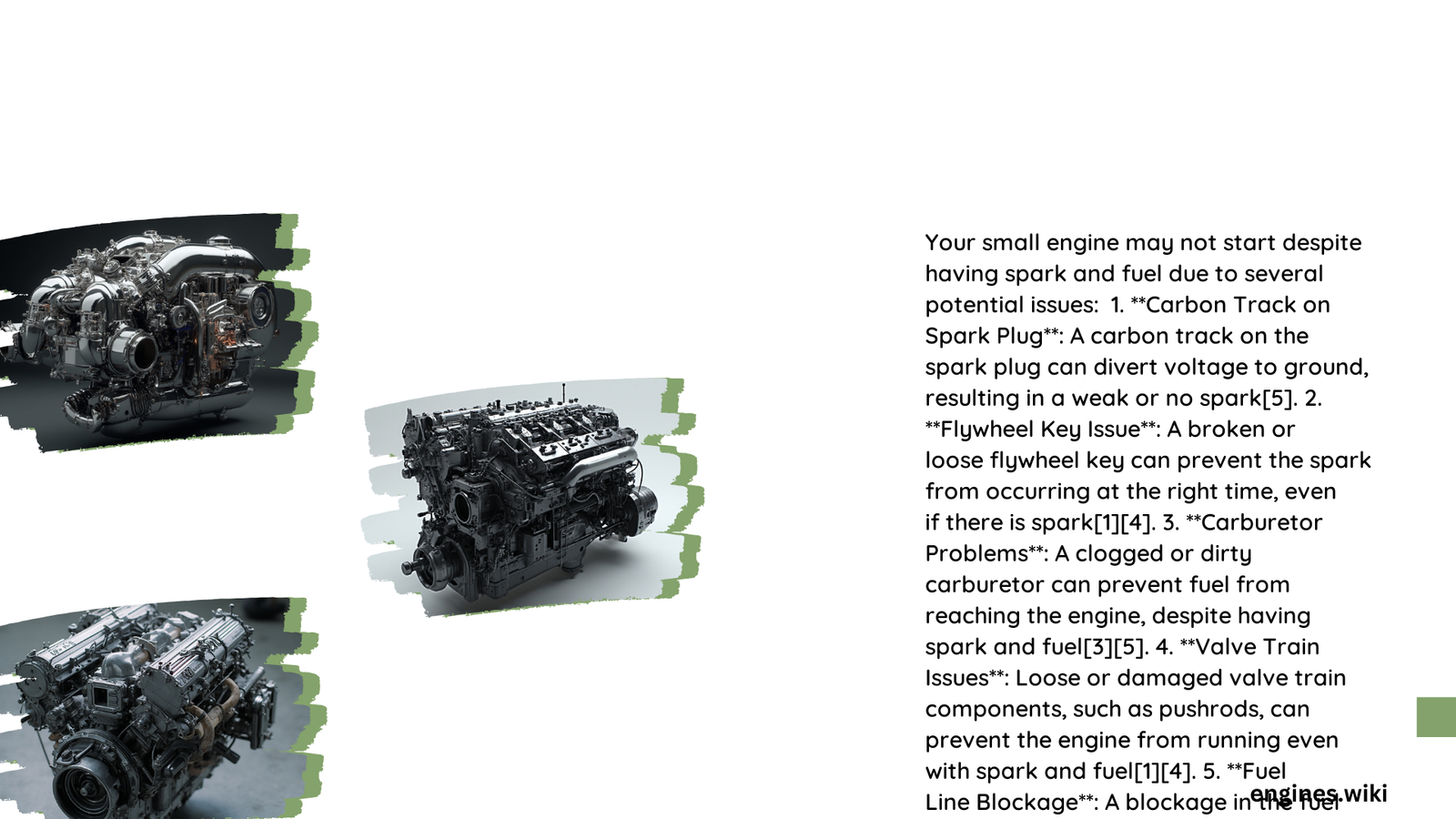Small engine starting issues can be frustrating, especially when you’ve confirmed the presence of spark and fuel. This comprehensive guide explores the common reasons behind a small engine’s failure to start despite having these essential elements. We’ll delve into fuel delivery problems, ignition timing issues, carburetor blockages, and compression failures, providing detailed insights and practical solutions to get your engine running smoothly again.
What Are the Main Causes of Small Engine Starting Problems?
When a small engine has spark and fuel but won’t start, several factors could be at play. The most common culprits include:
- Fuel delivery issues
- Ignition timing problems
- Carburetor blockages
- Compression failure
Let’s examine each of these potential causes in detail.
How Can Fuel Delivery Issues Prevent Engine Starting?

What Are the Key Components of Fuel Delivery?
The fuel delivery system in small engines is crucial for proper operation. It consists of several components:
- Fuel tank
- Fuel lines
- Fuel pump (if present)
- Fuel filter
- Carburetor
Each of these components must function correctly to ensure the engine receives the right amount of fuel at the proper pressure.
What Are Common Fuel Delivery Problems?
- Clogged Fuel Lines: Over time, fuel lines can become blocked with debris or old fuel residue.
- Faulty Fuel Pump: A malfunctioning fuel pump may not provide adequate pressure.
- Blocked Fuel Filter: A clogged filter can restrict fuel flow to the carburetor.
- Carburetor Issues: Problems within the carburetor can disrupt fuel delivery.
How to Diagnose and Fix Fuel Delivery Issues?
- Check fuel lines for blockages or kinks.
- Inspect the fuel pump and its connections.
- Replace the fuel filter if it’s clogged.
- Clean or rebuild the carburetor if necessary.
What Role Does Ignition Timing Play in Engine Starting?
Why Is Correct Ignition Timing Important?
Proper ignition timing ensures that the spark plug fires at the right moment in the engine cycle. Incorrect timing can prevent the engine from starting or cause poor performance.
What Causes Ignition Timing Problems?
- Worn or damaged spark plug: A faulty spark plug can disrupt timing.
- Faulty ignition coil: A bad coil may not produce a strong enough spark.
- Sheared flywheel key: This can cause the timing to be off significantly.
How to Check and Correct Ignition Timing?
- Inspect the spark plug for wear or damage.
- Test the ignition coil with a multimeter.
- Check the flywheel key for signs of shearing.
- Use a timing light to verify and adjust timing if necessary.
What Are the Effects of Carburetor Blockages on Engine Starting?
How Does a Carburetor Work?
The carburetor mixes air and fuel in the correct ratio for combustion. It consists of several small passages and jets that can become clogged over time.
What Are Common Carburetor Blockages?
- Clogged main jet: Prevents proper fuel flow at higher engine speeds.
- Blocked idle jet: Causes issues at idle and low speeds.
- Stuck float: Can prevent fuel from entering the carburetor bowl.
How to Clean a Carburetor?
- Remove the carburetor from the engine.
- Disassemble carefully, noting the position of all parts.
- Clean all passages and jets with carburetor cleaner.
- Use compressed air to blow out any remaining debris.
- Reassemble and reinstall the carburetor.
Why Is Engine Compression Important for Starting?
What Causes Low Compression?
- Worn piston rings: Allow combustion gases to escape past the piston.
- Leaky valves: Prevent proper sealing of the combustion chamber.
- Blown head gasket: Can cause compression loss between cylinders.
How to Test Engine Compression?
- Remove all spark plugs.
- Insert a compression tester into one spark plug hole.
- Crank the engine several times.
- Record the highest pressure reading.
- Repeat for all cylinders and compare to specifications.
What Are the Solutions for Low Compression?
- Replace worn piston rings.
- Adjust or replace faulty valves.
- Replace a blown head gasket.
- In severe cases, the engine may need to be rebuilt or replaced.
Conclusion
When your small engine has spark and fuel but won’t start, systematically checking these four areas – fuel delivery, ignition timing, carburetor condition, and engine compression – can help you identify and resolve the issue. Remember to always consult your engine’s manual for specific procedures and specifications, and don’t hesitate to seek professional help for complex repairs.
References
- Greg’s Small Engine: 6 Tips for Troubleshooting a Small Engine that won’t Start
- Briggs & Stratton: Troubleshooting small engine problems
- iFixit: SOLVED: not getting fuel to carb – Craftsman Riding Mower
- Small Engine Repair: Fuel System Troubleshooting
- Popular Mechanics: How to Clean a Small Engine Carburetor
